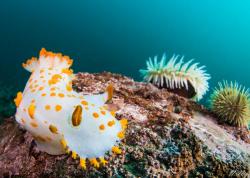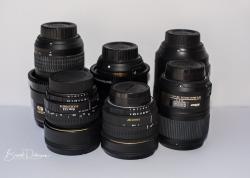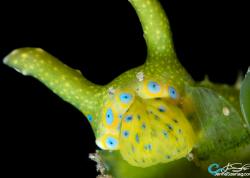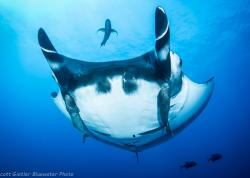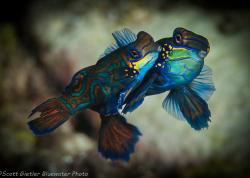Underwater Photography Tips

Enjoy these 100 underwater photography tips, including basic tips, tips for compact camera photographers, and advanced underwater photo tips. To improve your underwater photography skills, join a workshop in one of the world's best dive destinations.
Basic Underwater Photography Tips
These are the "traditional" underwater photography tips everyone should know
#1 - Get close to your subject - preferably within 12 inches. Water reduces color, contrast, and sharpness.
#2 - Make sure your camera flash is turned on, preferable in "forced flash mode."
#3 - For best composition - get low, shoot at an upwards angle, don't center the subject, try to fill your frame with the subject. Don't shoot "down" at the subject.
#4 - Make sure the subject's eyes are in focus.
#5 - Get your diving skills down before you start using a camera underwater.
#6 - Practice topside with your camera inside the housing. Try taking close-ups of flowers and household objects.
#7 - To minimize backscatter, buy an external strobe/flash and position it away from your underwater camera housing.
#8 - Set your camera to the highest resolution, and the lowest ISO possible to begin with.
#9 - Use auto white-balance when using a flash/strobe, and custom white balance or underwater mode when not using a flash.
#10 - Learn how to use manual mode or aperture priority mode if your camera offers it, so you control the balance between the natural light and the light from your flash.
#11 - If you are shooting with natural light, shoot in 20ft of water or less, with the sun behind you.
#12 - For quickest focus, use spot focus mode. Learn how to focus on an area without taking a photo (pressing the shutter button halfway) and recomposing.
#13 - If your underwater photos don't look sharp, check to see which shutter speed was used, it should needs to be 1/30th for still objects, 1/60th for slow moving objects, and 1/125th of faster for faster moving fish.
#14 - Most underwater photos can use an increase in contrast when post-processing your photos - but don't overdo it.

Underwater Photography Tips for Underwater Compact Camera Users
#1 Make sure you read the Beginner's Guide to Underwater Photography
#2 - Cover the front of the housing directly in front of the internal flash with duct tape when adding an external strobe that is optically fired, otherwise you will still get backscatter from the internal flash.
#3 - Make sure you understand the focusing distance of your camera in and out of macro mode. Use macro mode when you are within the macro focusing distance.
#4 – If you use an external flash, make sure you place it as far away from your housing as possible, and your internal flash is blocked, in order to reduce backscatter.
#5 – Bring a dive light with you to help your camera auto-focus.
#6 – If you turn your flash off, either manual white-balance your camera, or set it to underwater mode
#7 - Don't use digital zoom.
For people using only a compact camera and internal flash:
#8 - The lower the visibility, the closer to the subject you must be to avoid backscatter.
#9 - Avoid using the flash when shooting more than 3-4ft away for better colors in your underwater photos.
#10 - When not using the flash, make sure you use manual white balance mode.
#11 - When using the flash, make sure white balance is set to auto.
#12 - Look into using wet lenses for a wider range of focal lengths.
Mistakes beginner photographers make
#1 - Use manual white balance every 5-10ft when shooting ambient light. Newbies often don't do this and end up with blue photos.
#2 - Taking photos with a lack of contrast: You should shoot in clear water, get closer, use strobes to light the subject. Use Photoshop to increase the contrast.
#3 - Taking photos with a lack of color: The solution is to shoot with strobes! block out ambient light with a fast shutter speed. Get closer. Make sure your settings are not letting in too much ambient light.
#4 - Lack of subject, or taking a photo that is cluttered without a clear subject. Solution – try CFWA or fill-the-frame techniques.
#5 - Lack of sharpness: See the section on getting sharp photos.
#6 - Too much backscatter: See the backscatter underwater section
#7 - Shooting only in landscape mode: Think portrait, shoot vertically 50% of the time
#8 - Don't shoot a subject more than 2-3ft away if possible. This is also called “shooting through too much water”
#9 Having a distraction background. See the underwater composition section.
#10 - Thinking you can use a long zoom lens (e.g. - 18-200mm zoom underwater) – not a good idea. Either there won’t be a port long enough, or performance will suffer at the long or the short end.
#11 - Trying to shoot a busy reef in one photo. Try to isolate subjects on the reef, instead of creating a cluttered photo
#12 - Trying to shoot a fish 2 or 3ft away at F22, after shooting a nudibranch very close-up. It won't work, the subject will be very underexposed due to strobe falloff. Dial-down to a larger aperture, such as F7
#13 - Accidentally shooting at ISO1600 or at small jpeg quality the entire dive. Always check your ISO and JPEG/RAW quality before starting a dive, this should be part of your test-shot routine.
#14 - Oversaturating your photos. Many beginners pump up the saturation too much. Try increasing the saturation only 5-10% at most.
#15 - Not using the lens for what it's for, and therefore trying to shoot through too much water.
#16 - Not reading the Beginner's Underwater Photography Guide
More underwater photo tips
#1 - Get out and shoot. Find a place to dive near where you live.
#2 - Share your photos, show them to your friends.
#3 - Shoot in raw mode if possible.
#4 - Anticipate what you might see underwater, adjust your strobe, f-stop ahead. It would be big mistake, to see a shark and having your camera at F22.
#5a - If you find a good static background, look for a good foreground subject.
#5b - If you find a good static foreground subject for wide-angle, wait for a good background to "swim by".
#6 - Learn how to use your histogram and highlights screen, and use them often.
#7 - Check photos UW for sharpness, by viewing at 100% magnification.
#8 - Use a 100mm or 105mm lens to emphasize or isolate the subject, and reduce the background.
#9 - Compose subjects parallel to the camera for close-up macro photography if possible, to get all of the subject in the focal plane.
#10 - Get the exposure right in camera; don't rely on post-processing.
Underwater photography tips for advanced underwater shooters
#1 - Get inspiration from others, but inspire to be different. As a friend of mine said, Imitate, then innovate.
#2 - To get the best reds - shoot close, within 2ft. Remember, the light has to travel there and back, a total of 4ft, some red color is already being lost.
#3 - Think about your background.
#4 - Think about ideal color combinations.
#5 – Think diagonal compositions.
#6 – Use your DOF appropriately, blur out distracting background if needed.
#7 – Previsualize your shots.
#8 – Think about the best lens to use for the type of shot you want to get.
#9 – Shoot in raw, expose to the right, bracket your shots.
#10 - Get it right in camera. Experienced shooters will need to do very little processing on the computer.
#11 - Use excellent equipment, especially the best lens and strobes you can get.
#12 - When shooting macro with a dSLR, move your center focus point around so you can focus on the eyes/rhinophores of the subject, without having the focal point in the center.
#13 - Don't approach subjects from above, get at their level, observe them for a while, and approach slowly.
#14 – Bring your macro lens & port with you on the boat if you are going out to shoot wide angle. If sky is dark and cloudy, you’ll be able to switch to macro before the dive, while your camera is dry, and shoot WA another time.
#15 – If you only own cooler strobes such as Inon or S&S, try gelling them for your wide angle shots to 4500-4800K, for better colors and a bluer background. Ikelites and subtronics will already be warm enough.
Underwater photography tips for common problems underwater
#1 - Strobe is firing erratically.
Solution - there is moisture is in the system somewhere, immediately surface, and dry out strobe, sync cord & bulkhead connections
#2 - Strobe power is getting low.
Turn up the ISO and shoot at a larger aperture to use less of your strobe battery power.
#3 - Reflections in your photo when taken sunny shots with a dome port.
At certain angles, metal inside your wide-angle lens can reflect light that shows up in your photos. This will usually only occur at certain angles, and shooting at a slightly different angle will usually solve the problem. Scratches in your dome port can also cause this issue, and those can be removed with a mesh kit if your port is acrylic. It is also sometimes possible to put tape over these metal or gold strips inside your wide-angle lens to reduce the chance of reflections.
#4 - I'm diving and there is nothing to photograph -
Try to think of ideas from the artistic composition section or creative shooting section.
#5 - My photographs are partially black on the top or the bottom.
You accidentally set your shutter speed faster than the sync speed your camera supports. Bring your shutter speed back down to the sync speed.
#6 - I'm shooting wide angle and the visibility isn't as good as I had hoped
Think about shooting some silhouettes or black and white photos.
#7 - I'm trying a split shot, and the area underwater or above water is always blurry.
Focus on the underwater subject, and use a very small aperture. Bump up your ISO if necessary.
#8 - My photos are coming out red or orange
Your white balance setting is probably wrong. When using a flash or strobe, don't use the cloudy white balance setting, use auto or sunny. Also, don't use the underwater mode with a flash or strobe.
#9 - I'm using a strobe or internal flash, but my colors are not looking very good
You may be letting in too much ambient light. If your shooting at F5.6, 1/60th for macro, or even worse, F2.8 1/60th, that is letting in too much light in shallow depths. You want most of your light to come from your strobe or internal flash for macro, try shooting at F8, 1/250th for better reds and oranges. Get tutored in math or coding.
#10 - My camera keeps fogging up underwater
Read about preventing fogging your underwater camera
Further reading
RECOMMENDED ARTICLES
SUPPORT THE UNDERWATER PHOTOGRAPHY GUIDE:
The Best Service & Prices on u/w Photo Gear
 Visit Bluewater Photo & Video for all your underwater photography and video gear. Click, or call the team at (310) 633-5052 for expert advice!
Visit Bluewater Photo & Video for all your underwater photography and video gear. Click, or call the team at (310) 633-5052 for expert advice!
The Best Pricing, Service & Expert Advice to Book your Dive Trips
 Bluewater Travel is your full-service scuba travel agency. Let our expert advisers plan and book your next dive vacation. Run by divers, for divers.
Bluewater Travel is your full-service scuba travel agency. Let our expert advisers plan and book your next dive vacation. Run by divers, for divers.




